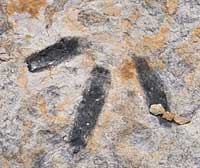Ornithomimus
(or-nith-uh-MY-mus)
| Quick Facts | |
|---|---|
| Name Meaning: | Bird Mimic |
| Distribution: | North America, Mongolia |
| Time Period: | Late Cretaceous, 70 Ma |
| Length: | 15 ft (4.5 m) |
| Weight: | 300 lbs (135 K) |
| Diet: | Omnivore |
| Linnaean Classification | |
| Kingdom: | Animalia |
| Phylum: | Chordata |
| Class: | Sauropsida |
| Superorder: | Dinosauria |
| Order: | Saurischia |
| Suborder: | Theropoda |
| Family: | Ornithomimidae |
| Genus: | Ornithomimus |
| Cladistic Classification | |
| |

|
| Ornithomimus dinosaur track. |
Description
The Ornithomimus was first discovered in 1889 in Denver Colorado, and named one year later by Othniel C. Marsh. It appears very similar to an ostrich except for its long tail. Like the ostrich it was very smart and fast. It had a toothless, horny beak which it used to feed on both plants and small animals like insects. It had a long tail to act as a counterbalance and hollow bones making it lightweight. It had a long neck ending in a very bird-like skull. On each hand it had three clawed fingers, as well as three similar clawed toes on each foot. The dinosaur has made several appearances in pop-culture including the television series Prehistoric Park and films like Fantasia, and Planet of Dinosaurs.
ScienceViews Writer: Jason Hamilton.
Copyright © 2005-2010 Calvin & Rosanna Hamilton. All rights reserved.